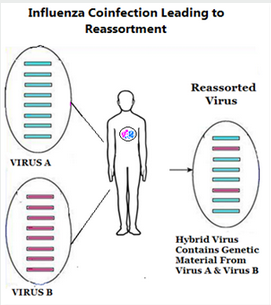#18,214
Although HPAI H5N1 remains poorly adapted to humans - and as an avian-adapted virus might never make that leap - there is one potential shortcut for it to become a pandemic virus; reassortment with a more `humanized' seasonal flu virus.
While reassortment - aka `Antigenic Shift' is fairly rare, as any virologist will tell you; Shift happens.
At least twice in my lifetime (1957 & 1968) an avian flu virus has reassorted with the current seasonal flu, to produce a new pandemic virus.
- The first (1957) was H2N2, which according to the CDC `. . . was comprised of three different genes from an H2N2 virus that originated from an avian influenza A virus, including the H2 hemagglutinin and the N2 neuraminidase genes.'
- In 1968 an avian H3N2 virus emerged (a reassortment of 2 genes from a low path avian influenza H3 virus, and 6 genes from H2N2) which supplanted H2N2 - killed more than a million people during its first year - and continues to spark yearly epidemics more than 55 years later.
While reassortment can happen in any susceptible host; pigs, birds, and humans are thought the most likely `mixing vessels'.
Luckily, most coinfections do not lead to the creation of a biologically `fit' hybrid. But the potential exists, and arguably has increased now that H5N1 has been detected in cattle, alpacas, and goats.
In today's HHS press teleconference, the CDC's Principal Deputy Director Nirav Shah announced their intention to launch a $5 million initiative to improve the uptake of the seasonal flu vaccine among livestock workers this fall. The hope is to get as many of the roughly 200,000 livestock workers in the nation vaccinated.
Although the seasonal flu shot is not expected to provide any protection against the H5N1 virus, it can help reduce the chances of a farm worker being simultaneously infected with seasonal flu.
It is not a perfect solution, since the seasonal flu shot is better at preventing serious illness than preventing infection. But given the downsides, it makes sense to try to reduce the the opportunities for a reassortment event that might provide H5N1 with a pathway to human adaptation.
For more on influenza coinfection, you may wish to revisit these blogs:
EID Journal: Human Co-Infection with Avian and Seasonal Influenza Viruses, China
J Clin Virol: Influenza Co-Infection Leading To A Reassortant Virus
Lancet: Coinfection With H7N9 & H3N2
(2011) Webinar: pH1N1 – H3N2 A Novel Influenza Reassortment
